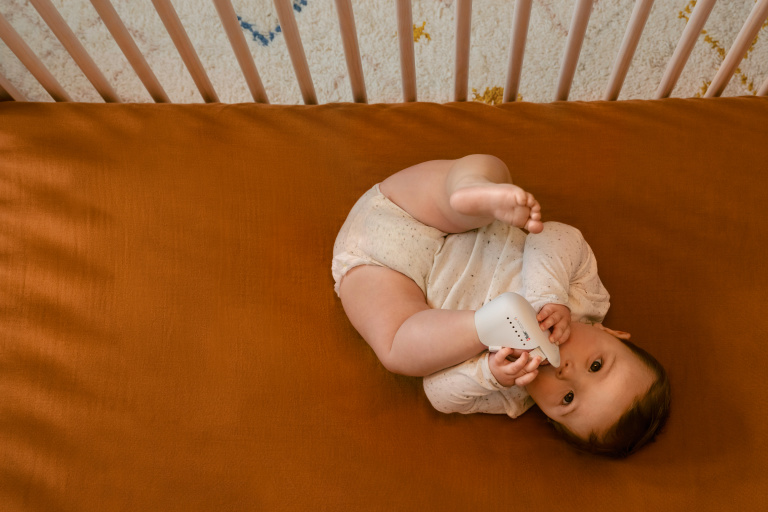6 Questions to Ask Before Choosing a Smart Baby Monitor or Regular Monitor
From health-data tracking to 24-hour video playback, here are some things to consider.
By Babylist Team
With so many different kinds of baby monitors out there—many of which call themselves “smart” monitors—how are you supposed to tell them apart? And what actually makes one smart? We’ve partnered with Masimo Stork to break down the differences to help you find one that’s right for your family.
What Kinds of Baby Monitors Are There?
Before we dive into the comparison, let’s start with the basics. There are three kinds of baby monitors: audio, video and smart monitors. Here’s the 411 on each one.
Audio monitor: Think of an audio monitor almost like a walkie-talkie; the transmitter unit goes in your nursery to pick up on any sounds baby might make while sleeping or when waking up, and the receiver stays with you. There are few limitations with an audio monitor—since you can’t see your child, you won’t know if they’re stirring or just making sweet baby sounds in their sleep. Most audio monitors have limited range, too (usually between 500-1,000 ft.). Price: $
Video monitor: Video monitors are a go-to way for parents to literally keep an eye on their baby overnight. Camera quality ranges from brand to brand, but most offer features like zooming, tilting and night vision. Many newer models also have two-way communication so you can hear (and speak to) your little one, too. Price: $$
Smart monitors: Smart monitors combine the features of audio and video monitors and add a lot more capabilities like built-in white noise and the ability to connect to a WiFi network so you can see and hear your baby via smartphone from anywhere. But the standout feature these monitors offer is health data tracking (like pulse rate and oxygen saturation) along with a more in-depth look at baby’s sleep patterns. While they’re typically on the higher end of baby monitor prices, many parents find the extra peace of mind to be worth it. Price: $$$

Every smart monitor is a little different. Some track breathing motions, others track sleep positions, but if you’re hoping for advanced-level info, you may want to look for a smart monitor that tracks things like pulse rate, oxygen saturation levels and skin temp, like the Stork Smart Home Baby Monitoring System. It tracks your baby’s health data using the same technology hospitals use to monitor more than 10 million babies every year*—a major benefit for new parents who want extra overnight insights.

How Do Smart Monitors Track Health Data?
Some smart monitors use wearables like swaddles, while others work without a physical sensor. But not all smart monitors gather their info in the same way using the same technology. For example, Masimo Stork uses the same tech that hospitals have trusted in the NICU for over 25 years—called Signal Extraction Technology (SET)—in its sensor. Placed inside of the soft, flexible Stork Boot, it tracks baby’s key health data three ways: pulse rate, oxygen saturation and skin temperature. And if you’re wondering, “will my baby keep that thing on?” don’t worry. Comfy latches keep the boot secure even if your baby is a professional sock remover.

What Do Smart Monitors Update You To?
Smart monitors tend to be more proactive than regular monitors. This means you might expect to get helpful updates such as alerts to changes in your baby’s room conditions—like temperature and humidity—both of which can impact baby’s comfort level while they sleep. For added sleep safety, Stork’s system provides visual and audio alarms when baby’s oxygen saturation and pulse rate fall outside of preset ranges. It also alerts you to baby’s sleeping position and lets you know if they’ve turned face down. In a nutshell, it allows you to stand watch without having to be glued to a monitor screen all the time.
What You Get Access to with a Smart Monitor
Here’s another perk to smart monitors: video playback. Most offer snapshots or snippets of video history, but Stork’s unique system lets you look back at a full 24 hours of video, which makes reviewing any happenings during bedtime or naptime much easier. Want to know exactly when baby’s first big rollover happened? Now you can see it while getting a full look at any other changes to their health data. And since Stork monitors continuously, your baby’s data will always be accurate (some other monitors only share averages).
How to Tell If a Smart Monitor Is Right For You
Not everyone needs the highest tech baby gear out there, but if you’re the kind of parent who peeks into baby’s nursery every 15 minutes, wakes up at 2 AM because because of phantom cries or just really likes the idea of a fully loaded monitor, then a smart monitor like Stork might be a good fit. Check out more in our video here.
The Stork system is not intended for use as a medical device. * Estimate: Masimo data on file. Product varies by bundle.
This article is sponsored by Masimo Stork. Babylist’s free site, apps and emails are made possible by our sponsors. We limit our sponsored content to relevant partners that offer products and services we believe in and use ourselves.


